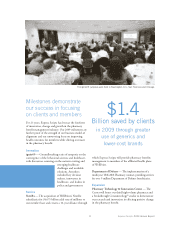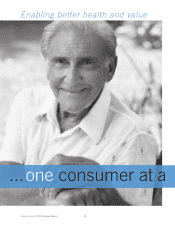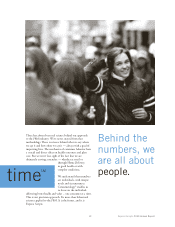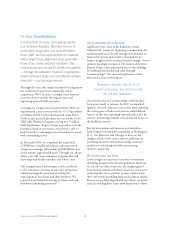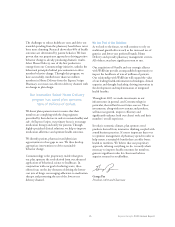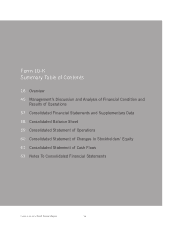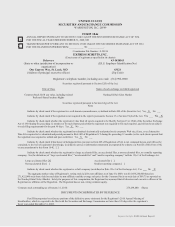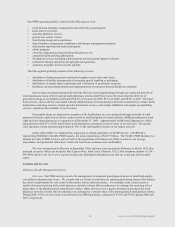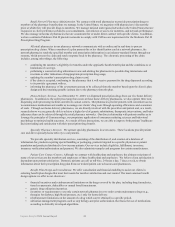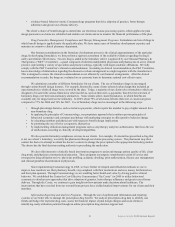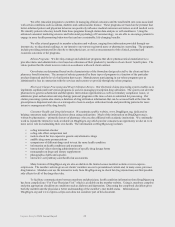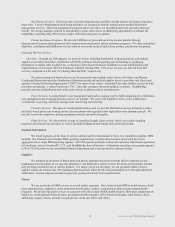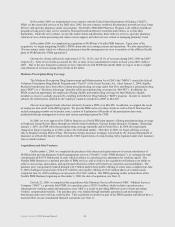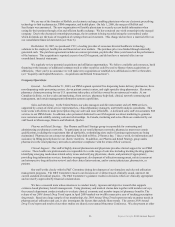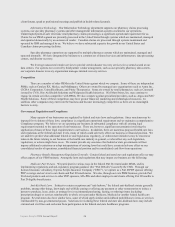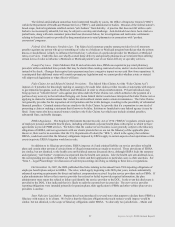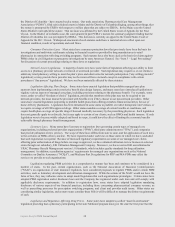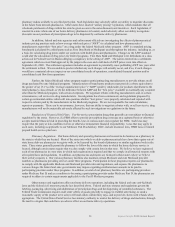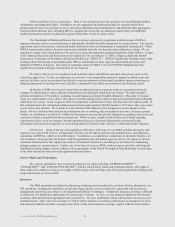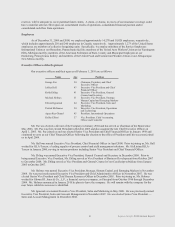Express Scripts 2009 Annual Report Download - page 23
Download and view the complete annual report
Please find page 23 of the 2009 Express Scripts annual report below. You can navigate through the pages in the report by either clicking on the pages listed below, or by using the keyword search tool below to find specific information within the annual report.
Express Scripts 2009 Annual Report
21
• evidence-based, behavior-centric Consumerology programs that drive adoption of generics, better therapy
adherence and greater use of home delivery.
The client’s choice of benefit design is entered into our electronic claims processing system, which applies the plan
design parameters as claims are submitted and enables our clients and us to monitor the financial performance of the plan.
Drug Formulary Management, Compliance and Therapy Management Programs. Formularies are lists of drugs to
which benefit design is applied under the applicable plan. We have many years of formulary development expertise and
maintain an extensive clinical pharmacy department.
Our foremost consideration in the formulary development process is the clinical appropriateness of the particular
drugs. In developing formularies, we first perform a rigorous assessment of the available evidence regarding the drug’s
safety and clinical effectiveness. No new drug is added to the formulary until it is approved by our National Pharmacy &
Therapeutics (“P&T”) Committee – a panel composed of nineteen independent physicians and pharmacists in active clinical
practice, representing a variety of specialties and practice settings, typically with major academic affiliations. We fully
comply with the P&T Committee’s clinical recommendations. In making its clinical recommendation, the P&T Committee
has no knowledge of information regarding the discount or rebate arrangement we might negotiate with the manufacturer.
This is designed to ensure the clinical recommendation is not affected by our financial arrangements. After the clinical
recommendation is made, the drugs are evaluated on an economic basis to determine optimal cost-effectiveness.
We administer a number of different formularies for our clients. The use of formulary drugs is encouraged
through various benefit design features. For example, historically, many clients selected a plan design that included an
open formulary in which all drugs were covered by the plan. Today, a majority of our clients select formularies which are
designed to be used with various financial or other incentives, such as three-tier co-payments, that drive the selection of
formulary drugs over their non-formulary alternatives. Some clients select closed formularies, in which benefits are
available only for drugs listed on the formulary. In 2009, about 79% of all claims fell into three-tier or closed categories
compared to 77% for 2008 and 76% for 2007. Use of formulary drugs can be encouraged in the following ways:
• through plan design features, such as tiered co-payments, which require the member to pay a higher amount for a
non-formulary drug
• by applying the principles of Consumerology, our proprietary approach that combines proven principles of
behavioral economics and consumer psychology with marketing strategies to effect positive behavior change
• by educating members and physicians with respect to benefit design implications
• by promoting the use of lower cost generic alternatives
• by implementing utilization management programs such as step therapy and prior authorization, that focus the use
of medications according to clinically developed algorithms
We also provide formulary compliance services to our clients. For example, if a doctor has prescribed a drug that
is not on a client’s formulary, we notify the pharmacist through our claims processing system. The pharmacist may then
contact the doctor to attempt to obtain the doctor’s consent to change the prescription to the appropriate formulary product.
The doctor has the final decision-making authority in prescribing the medication.
We also offer innovative clinically based intervention programs to assist and manage patient quality of life, client
drug trend, and physician communication/education. These programs encompass comprehensive point of service and
retrospective drug utilization review, physician profiling, academic detailing, prior authorization, disease care management,
and clinical guideline dissemination to physicians.
Since implementing Consumerology in 2008, we have further developed and refined the methods we use to
improve how members use their pharmacy benefit, stay compliant with their medications and save money for themselves
and their plan sponsors. Through Consumerology we are enabling better health and value by driving positive clinical
behavior. We established the Center for Cost-Effective Consumerism (“the Center”) in 2008 to utilize behavioral
economics to develop new approaches that drive adoption of generics, better therapy adherence and greater use of home
delivery. Through the Center, we continue to gain insight into how patients make decisions about healthcare. The
interventions that have resulted from our test-and-learn process have yielded marked improvements for our clients and their
members.
Information Reporting and Analysis Programs. Through the use of sophisticated information and reporting
systems we are better able to manage the prescription drug benefit. We analyze prescription drug data to identify cost
trends and budget for expected drug costs, assess the financial impact of plan design changes and assist clients in
identifying costly utilization patterns through an online prescription drug decision support tool.


